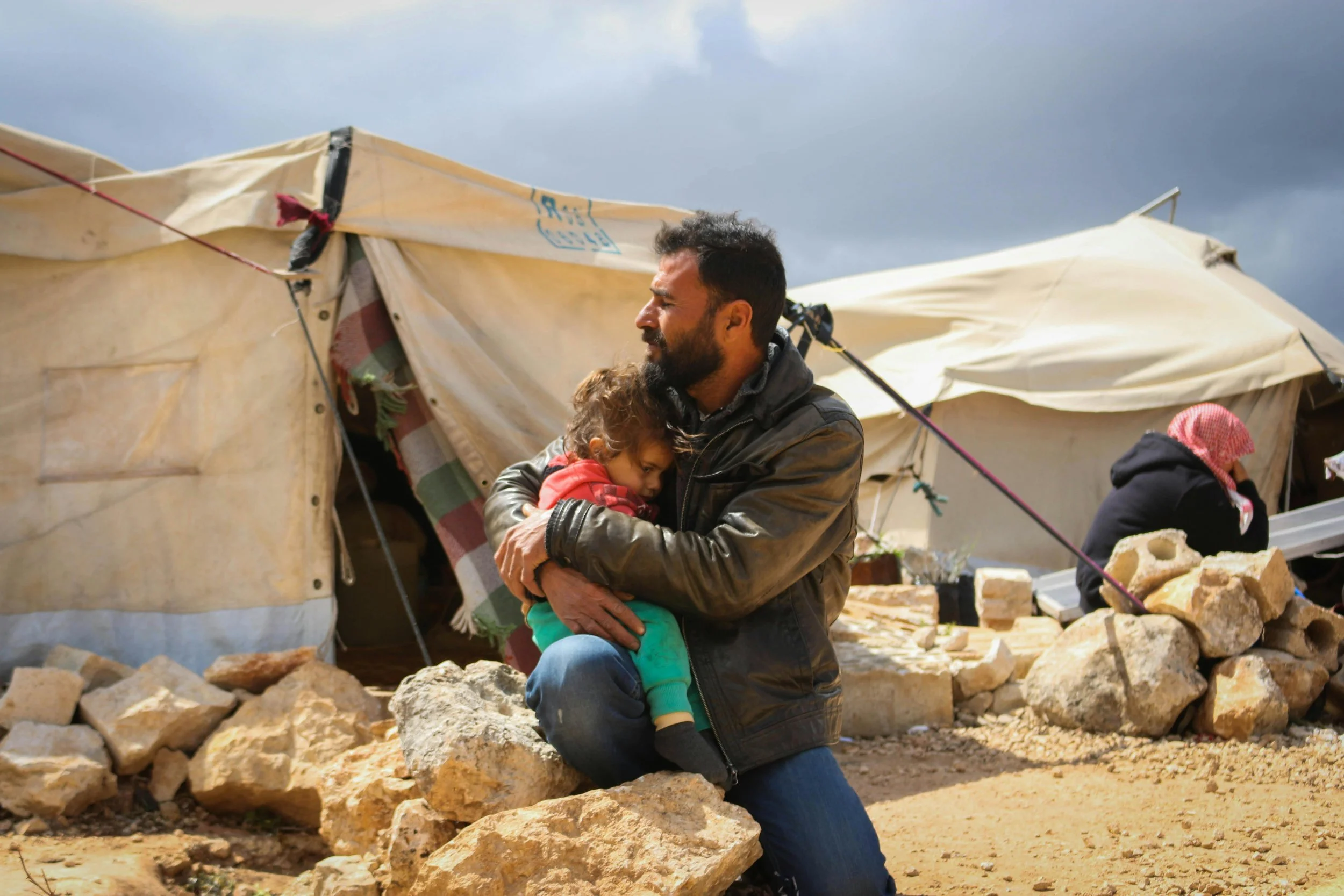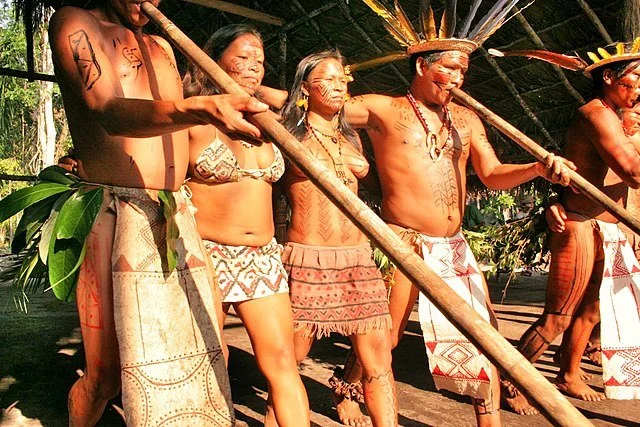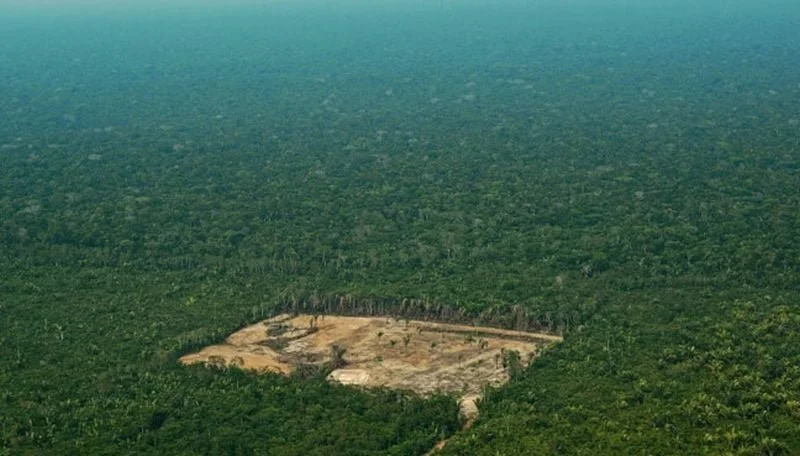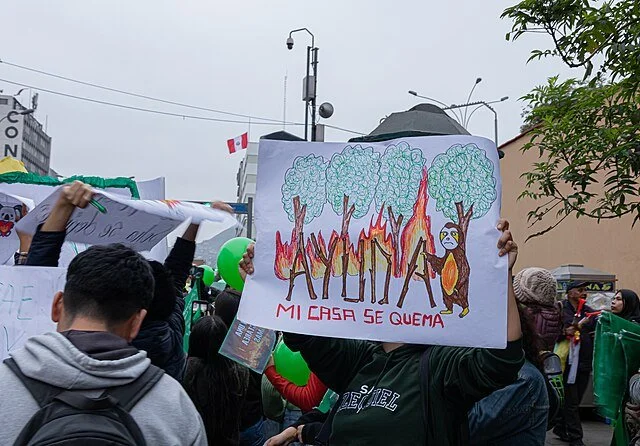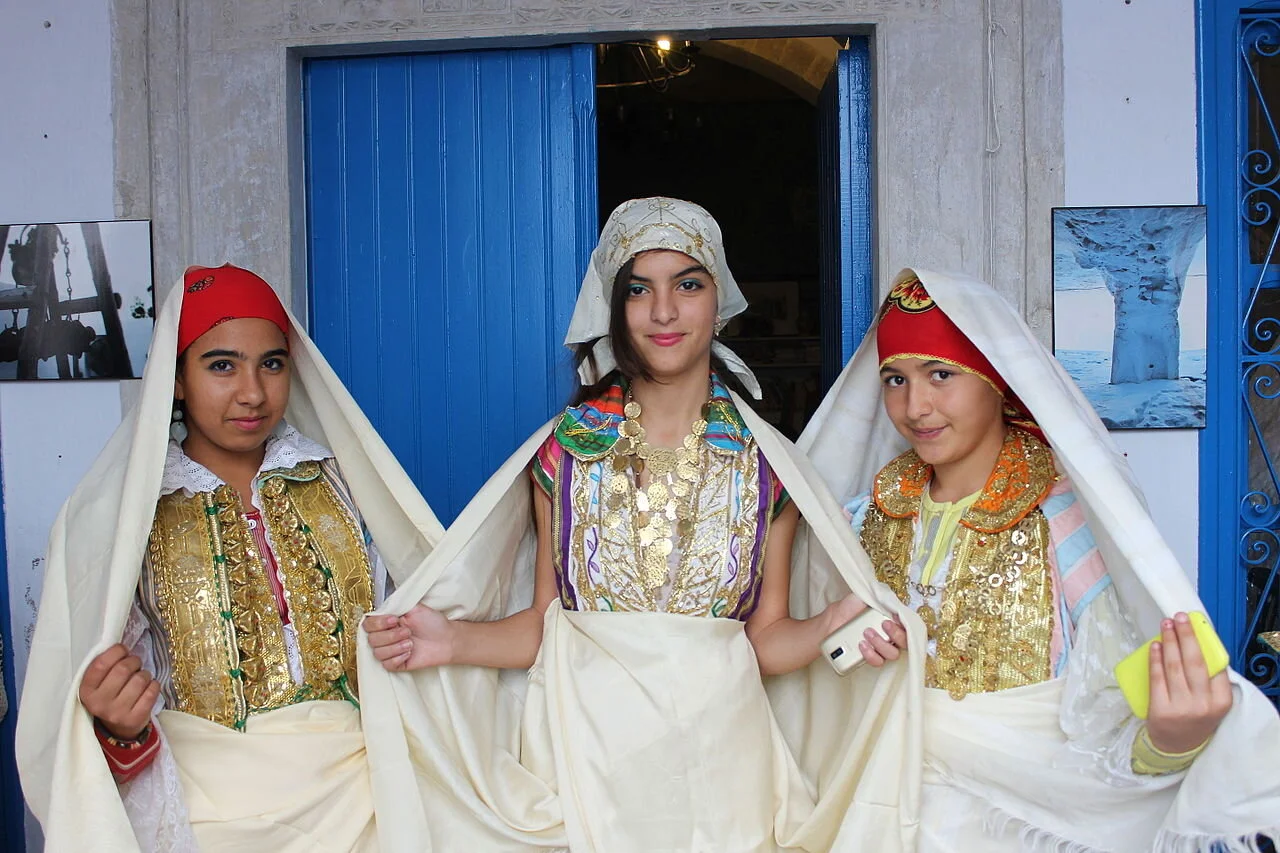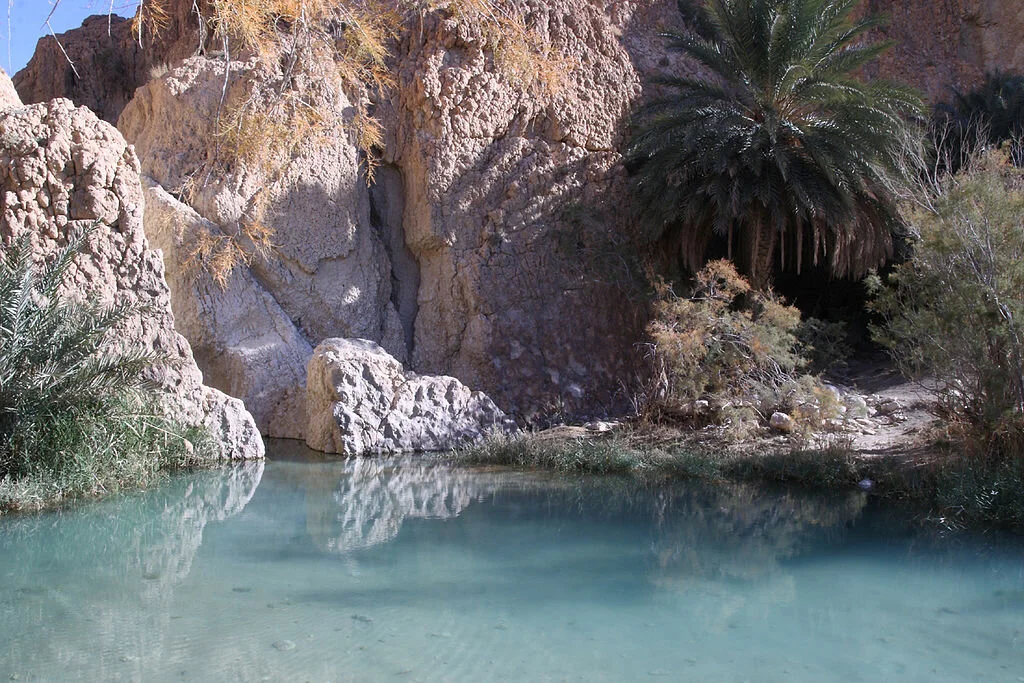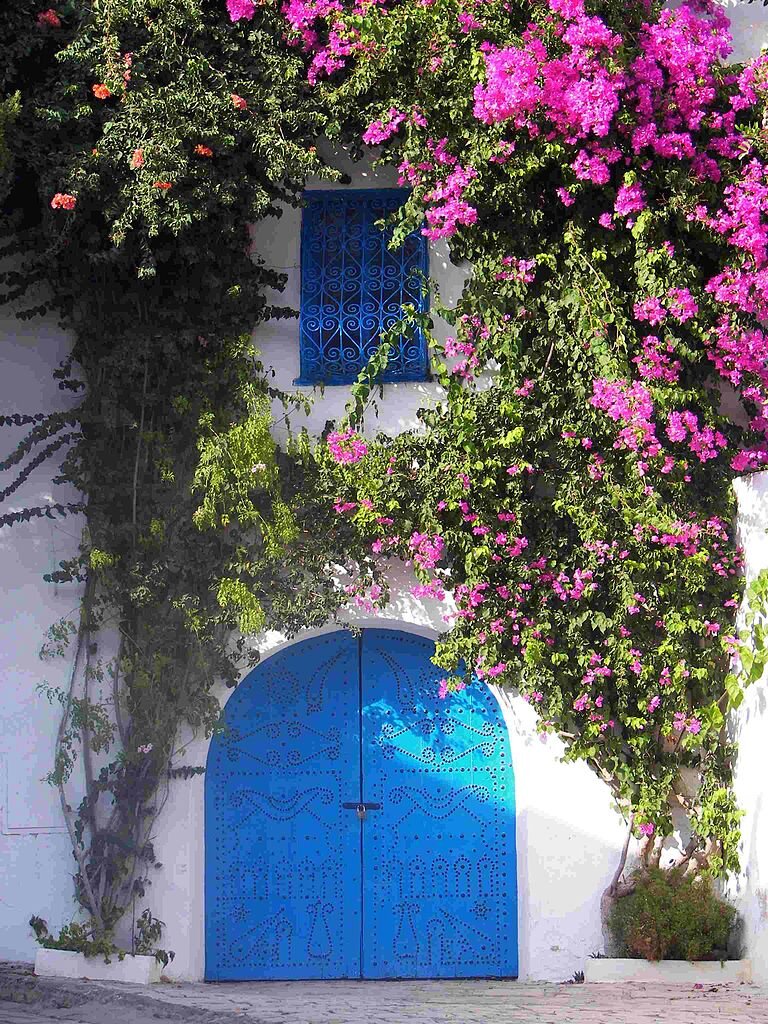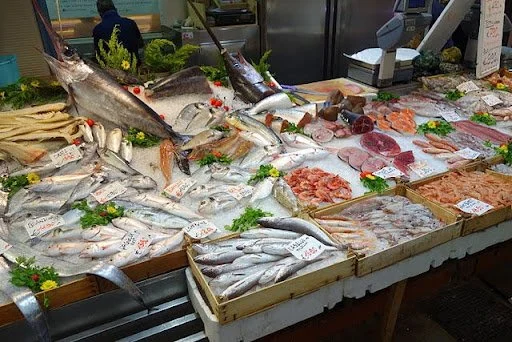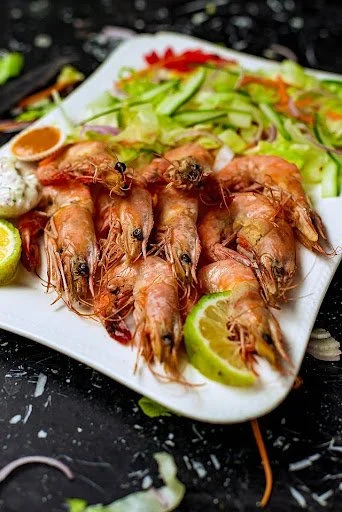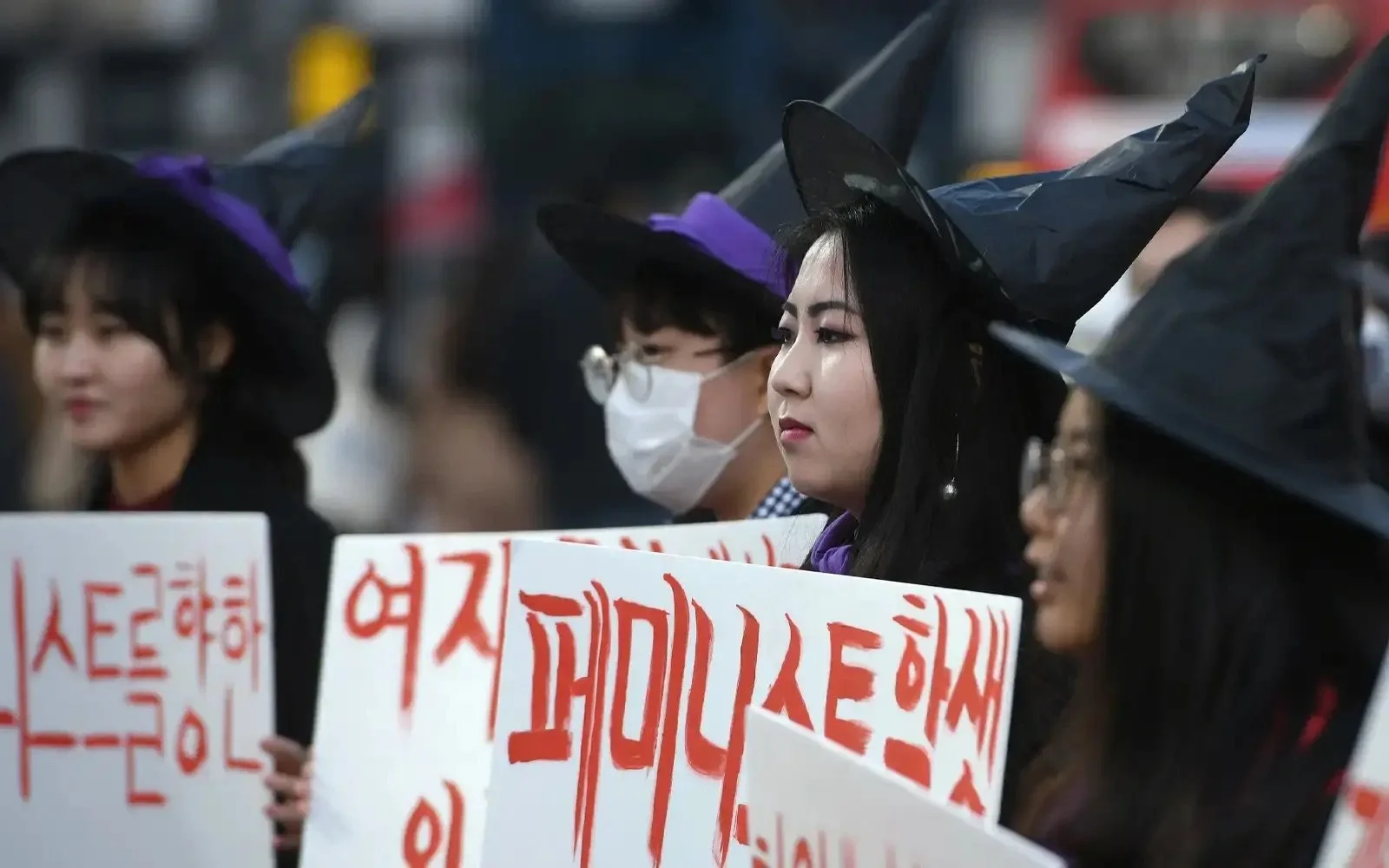After two years of famine, disease, and misery, the U.S. has given an official deemed the ongoing conflict in Sudan as genocide.
Read MoreSmall Towns Redefining Sustainable Tourism
Environmentally conscious values have made their way to the forefront of travel so lesser-known destinations can leap into the ecotourism limelight. Learn how small towns are redefining sustainable tourism.
Read MoreLive Like a Local in Madrid
Skip the tourist traps in this fantastic Spanish city with advice from a traveler who has food, wine, sunset, bars, and dancing recommendations in the city of Madrid.
Read MoreCelebrating Lunar New Year Across China
Falling on Jan. 29, 2025, the Lunar New Year is a time of celebration across China, commemorated by unique traditions found in each of its culturally diverse regions.
Read More5 Ancient Pilgrimages You Can Still Hike Today
Five ancient pilgrimages around the world you can still hike today! Visit them in Spain, Japan, Peru, the Middle East, and Sri Lanka.
Read More6 Tropical Countries To Escape the Winter Chill
Avoid the cold temperatures of winter by taking off to these six tropical destinations around the world, each offering a lush climate and magical adventures.
Read MoreA New Dawn for Syrian Refugees
The fall of Assad’s regime has left the world wondering about the future of Syrian refugees abroad who plan to return home.
Man and daughter at Syrian refugee camp. Ahmed Akacha. CC0.
The Syrian Refugee Crisis is one of the largest humanitarian crises in history and the largest refugee crisis to date, with over 14 million people both internally and externally displaced. Over six million Syrians fled the country following the civil war that broke out in 2011; the majority of refugees currently live in Turkey, Lebanon, Jordan, Iraq, Egypt and Germany.
President Bashar al-Assad’s violent suppression of pro-democracy protests in 2011 provoked civil conflict, leading to the creation of oppositional militias and rebel groups that began to fight back by 2012. On Dec. 8, 2024, the civil war came to a head when rebel groups seized the Syrian capital, Damascus, forcing Assad to flee to Russia. Assad’s family had ruled Syria under a strict police regime since the 1960s, leading to widespread celebration across the capital as political prisoners were freed.
Despite rebel groups declaring the country free from the autocratic regime, considerable uncertainty remains about the future of the government and Syria’s stability. Some states have expressed a concern that toppling the government may make the country vulnerable to ISIS, whereas others have noted the encroachment of Israeli forces into Syrian buffer zones. The European Union issued a statement claiming that the conditions in Syria have not yet met the conditions for the safe return of refugees, as thousands have continued to flee following the rebel takeover. However, in the days following, videos swept across social media and news outlets featuring thousands of refugees returning home from Turkey, Jordan and Lebanon.
European countries hosting hundreds of thousands of Syrian refugees, including Germany and Austria, have jumped at the opportunity to tighten their asylum regulations. In December 2024, both Germany and Austria paused asylum applications, and Austria announced that they would issue a “return bonus” to Syrians who decided to return to Syria.
Providing incentives or forcing refugees to leave the country could adversely affect host countries, particularly Germany. Approximately two-thirds of employed Syrian refugees in Germany work in critical sectors of the labor force, including healthcare, transportation and food services. Whether forced or voluntary, any kind of mass exodus could negatively affect Germany’s economy by disrupting these industries and causing labor shortages.
Following an outcry from far-right German politicians to close the country’s borders and begin the expulsion of non-naturalized Syrians, current Chancellor Olaf Scholz said that Syrians who are “well-integrated remain welcome in Germany.” However, the Chancellor’s statement may prove unstable, presenting no active policy arrangements if the far-right parties gain control in the upcoming elections and creating further uncertainty for Syrians currently living in Germany.
The United Nations High Commissioner for Refugees advised that countries housing refugees should not forcibly deport them, as Syria is not yet deemed politically stable, and it is estimated that over one million Syrians will return to Syria of their own accord in the first few months of 2025.
Despite this monumental step forward, considerable humanitarian and governmental uncertainty remains surrounding the future of Syrians worldwide, a resolution that may take years to completely unfold.
Zoe Lodge is a student at the University of California, Berkeley, where she is studying English and Politics, Philosophy, & Law. She combines her passion for writing with her love for travel, interest in combatting climate change, and concern for social justice issues.
A Portable Solution to the World’s Water Crisis
Hydro Wind Energy’s Quench Sea device offers a portable solution to the global water crisis, providing communities with access to clean drinking water through innovative desalination technology.
Read More7 Must-See Festivals Across Asia
Visiting a country during a cultural festival can be an amazing experience. Once travel resumes, plan a trip to one of these top festivals in Asia. From the Bali Kite Festival to the Desert Festival of Rajasthan, and learn of many more.
Read MoreNorth-East India’s Women-Only Market
Manipur’s Mothers’ Market is a world of resilience and resistance, where tradition, activism, and community converge in unexpected ways.
I decide on the Ima frying whiteish dough balls over a stand-alone stove and gas canister. ‘Aloo,’ she smiles and gestures to the wooden bench next to a young man slurping a leafy soup. Seconds later, this plump woman serves me a lunch of grilled fish, unidentifiable green veg, those fried potato balls, banana leaf, rice, and then, despite my protests, several second helpings.
The Imas are lined up behind their gas stoves, enticing the locals with their jokes and salty fish dishes. Sitting opposite, in front of stacked ceramic pots, are two more, warming their hands over the burning embers of a square metal pot. My host, Suporna Devi, is one of over 4000 women who congregate daily, in Ima Keithel, Manipur’s main market, selling everything from temple paraphernalia to locally-caught eels.
But, unlike the rest of India, here men are forbidden from trading. Passed down the generations, a stall at Ima Keithel, meaning ‘Mothers’ Market’, is highly coveted and provides the local Imas with an important source of income. Spilling out of the market buildings, encroaching on the roads, under the concrete flyovers, women are everywhere, selling produce. Some are eating, some reading, some sleeping. Many are chatting.
Believed to date back to the 16th century, the origins of Ima Keithel are unclear. Sandwiched between Myanmar and the Indian state of Assam, Manipur has long been forced to fight the Burmese and Chinese to retain its autonomy. A forced labour system, called Lallup Kaba, sent the men far from home to fight these wars, leaving the women at home to cultivate the land and sell the produce, possibly fostering this peculiar phenomenon.
For thousands of years Manipur remained an independent kingdom and a crossroads of trade and cultural exchange until it was conquered by the British in 1891. The golden, oval valley fringed by misty blue hills was famously called ‘the Jewel of India’ by India’s first prime minister. It is home to a diverse mix of tribes, who ethnically share more with groups in Burma than with the rest of India. Several hard day’s travel from Delhi, Manipur feels like a faraway land compared to India I’ve come to know; somewhat familiar, but yet not. A unique language and alphabet add to my disorientation.
The two large market buildings sit in the commercial heart of Imphal, a dusty, grey city, home to as many motorbikes as people. Mornings see the city enveloped in a heavy, December mist, which she usually manages to shed by lunchtime. Most ladies are sitting under bright shawls: many baring two pale vertical lines on their foreheads, meeting on the nose: the mark of local Hindus. I feel the weight of eyes as I circle the floor. But smiles are soon reciprocated with smiles, and many proudly remove their glasses to strike a poise for my camera. Before long, I fall foul of the sly sales pitch of an unassuming mother and daughter. Several tea-towels later, I note to myself this is still India.
When I reach Suporna Devi’s stall, I am thankful for the rest, and we are soon conversing, in a broken fashion, through Hindi, her third language. She has worked here for over 20 years, she tells me, inheriting the pitch from her aunt. Pointing to a poster, emblazoned with hammer and sickle, she exclaims, “this is not just a marketplace, but also a place of protest!”
The revolutionary slogans spray-painted to the outer walls point to a more complex story, and I have started to research Manipur’s matriarchal society. Since at least the early 20th century, the Manipuri women have been wielding a strong influence over political and social matters of the state, with Ima Keithal at the centre of the movement. The market developed as a place not only of trade, but as a centre for gathering, a source of the latest news, a place to discuss ideas. The mothers of Ima Keithel started credit unions, lending to women who wanted to started businesses, and mentored them in the process.
As she ladles yet more rice onto my plate, Suporna suggests I visit the Nupi Lal (Women’s War) monument in another part of central Imphal. This is a memorial to Imas who fought the British rulers in the 1930s over attempts to export local rice to British battalions in other territories. Locally rice became scarce, the price spiralled and the Manipuris began to suffer. The Imas protested, peacefully, but were met with attempts to sell the market buildings. They refused to relent and eventually military and police forces were unleashed against the unarmed females. Although the export policy was eventually repealed, many women lost their lives in the struggle.
During the Second World War, Manipur became a battleground for the war between the British and Japanese: this part of India is scarred with war graves. With the independence of India, a ravaged Manipur was absorbed into the new country, unleashing a seemingly indefinite cycle of violence and insurgency as anti-Indian and ethnic groups fought over differing visions for the state’s future. From 1980 until today, most of the state has been classified as a ‘disturbed region’ by the Indian government, a ruling designed to give the Indian Army additional powers to help them maintain public order. In practice, it has granted them immunity from prosecution for a range of heinous crimes.
Despite the departure of the British, for the Imas of Manipur, the oppression continues and their imaginative responses evolve. From torching liquor stores and fining drunk men, to protesting, naked, outside an Indian army base against a case of rape and murder by the armed forces, their actions are undoubtedly radical in a country where the majority of women have little say in domestic or societal affairs. Today, they are continuing to hold out against the talons of globalisation: recent attempts by the local government to replace the market with a modern supermarket were derailed by round-the-clock sit-ins by the Imas. Again they succeeded.
After a few days of loitering around Imphal, chatting and drinking chai, I decide it is time to leave the Imas. Several check where I am going, who with, and most importantly, have I eaten yet? I gesture to the fish section at the back of the market and they nod approvingly. After my last meal, I ask Suporna if she enjoys her work in the market. She smiles and says, “This is not just my work. This is my life.” I tell her I am leaving. “Vapis ana,” (come again) she says, and goes on frying her potato balls. I heave on my backpack and head for the bus.
How to get there: I took the bus from Guwahati, Assam. It was an uncomfortable, although beautiful journey that crossed through the hills of Nagaland on the way. There are also direct flights from Delhi, Calcutta and Guwahati. Imphal makes a convenient stop if travelling overland from North-East India into Myanmar through the recently opened Moreh-Tamu border crossing.
Where to stay: The Hotel Nirmala has decent rooms starting at 850 INR. Aheibam Homestay is a good budget option.
Where to eat: The stalls of Ima Keithel, of course. And the Luxmi Kitchen does a mean thali.
Eileen McDougall
After a decade working in London, Eileen swapped flashy buildings for a notepad and camera and set off for Asia. She fell in love with India, and it was here she started to write about her travels and the culture she was becoming immersed in. She is at her happiest on a bus alone heading off to somewhere new but seems to spend most of her time near mountains, mainly the Himalayas.
Barring Basic Rights: Uganda’s Anti-Homosexuality Regulation
Modern anti-gay regulations continue to threaten the lives and safety of Ugandan LGBTQ+ individuals.
Group Marching in Support of Uganda’s LGBTQ+ Community. Alisdare Hickson. CC BY-SA 2.0.
Known for having one of the world’s harshest LGBTQ+ rights records, the Ugandan parliament has pursued longstanding efforts to diminish same-sex activity within the country. As a result of 19th-century British colonization, the severe criminalization of homosexuality set the stage for modern homophobic sentiments. This culminated in the Anti-Homosexuality Act of 2023, which was later upheld by the Ugandan parliament in April 2024.
The 2023 Anti-Homosexuality Act was signed into law by Ugandan President Yoweri Museveni in May 2023, enforcing strict restrictions against LGBTQ+ individuals. Implementing harsh penalties, the act demands life imprisonment for consensual same-sex activity and the death penalty in cases of “aggravated homosexuality,” a term that denotes any same-sex act that involves people under 18, older than 75, those with a disability, or when consent is not given or cannot be given. This act is not the first attempt to limit LGBTQ+ rights in Uganda. In 2010, the Ugandan parliament passed a bill introducing similarly anti-gay legislation that was eventually ruled illegal by the constitutional court due to its lack of necessary quorum. In 2021, however, the president succeeded in passing a sexual offenses bill that criminalized same-sex relationships and sex work in Uganda.
While the Ugandan government has praised such legislation as acting in the country’s best interest, the persistent condemnation of same-sex actions has negatively impacted the lives of LGBTQ+ Ugandans. This has not only promoted anti-gay views but has also threatened lives through the reduction of HIV prevention and perpetuation of societal abuse. In an interview with Amnesty International, Ugandan activist and founder of the gay and intersex rights organization Freedom and Roam Uganda (FARUG), Jacqueline Kasha described the new law’s impact on her community. She contends that advocacy and visibility for LGBTQ+ individuals have sharply diminished with the aggressive crackdown: “Several LGBTI persons have since gone underground which is now impeding all our efforts, especially in the health sphere in the fight against HIV, mental illness and economic disparities.” The 2023 Act has allowed anti-gay groups to accuse or arrest people with little evidence or reasoning. As such, LGBTQ+ individuals are vulnerable to attack when outside the safety of their homes, forced to hide their identities under the threat of violence. Furthermore, those in need of HIV services have become disproportionately vulnerable to health risks, driven away from receiving care due to fear of criminal punishment or discrimination.
The first case of “aggravated homosexuality” has already come into effect: 21-year-old Michael Opolot was arrested in August 2023 after allegedly participating in public sexual activity with another man reported to have a disability. While the new act permits this arrest, there has not been any evidence submitted by police to substantiate claims that the alleged victim is disabled and therefore could not give consent. Opolot’s case has provoked Ugandan activists to challenge the law's constitutionality, citing the act’s contradiction of citizens’ freedom from discrimination and rights to privacy and health. Moreover, they have noted that Opolot’s case demonstrates the senseless oppression of LGBTQ+ individuals. Ugandan activist Clare Byarugaba affirmed that this mistreatment not only violates human rights but also suppresses advocacy, as “activists, public health workers, and others face long prison sentences and hefty fines” for attempting to voice support.
As a result of such political, social and health persecution, the LGBTQ+ population in Uganda has been left unprotected and endangered by intimidating threats. Although Uganda’s government views the recent passing of anti-homosexual legislation as a “step forward” for the country, many in the LGBTQ+ community have experienced the opposite result in their daily lives. Several international organizations and governments have commented on the bill, with United States President Joe Biden describing the act as a “tragic violation of universal human rights,” and the Joint United Nations Programme on HIV/AIDS (UNAIDS) explaining that “criminalizing populations most at risk of HIV, such as the LGBTQ+ communities, obstructs access to life-saving health and HIV services.” Despite such international criticism, anti-homosexuality continues to loom largely over Uganda and LGBTQ+ existence within the country.
TO GET INVOLVED
Those looking to support LGBTQ+ communities in Uganda can do so by getting involved with organizations dedicated to supporting individuals inside the country as well as those who have fled. Such organizations include: Sexual Minorities Uganda (SMUG), an LGBTQ+ advocacy organization, Universal Coalition of Affirming Africans Uganda (UCAA - UG), a human rights organization advocating for human rights and marginalized people, and Global Black Gay Men Connect (GBGMC), a group collaborating with Uganda Key Populations Consortium (UKPC) and SMUG to launch an emergency response fund to support LGBTQ+ Ugandans.
Julia is a recent graduate from UC San Diego majoring in Sociocultural Anthropology with a minor in Art History. She is passionate about cultural studies and social justice, and one day hopes to obtain a postgraduate degree expanding on these subjects. In her free time, she enjoys reading, traveling, and spending time with her friends and family.
Train Ride the Sahara: Mauritania’s Hidden Adventure
One of the world’s least-visited countries, Mauritania is home to a travel experience like none other, inviting daring travelers to embark on an unpredictable journey through the desert.
The desert nation of Mauritania attracts only around 30,000 visitors a year, making it one of the least visited countries in Africa and around the world. The country is not seen as a highly desirable travel destination due to the fact that it is only about 0.5% arable land and one of the least densely populated nations in the world. Mauritania is also one of the poorest countries worldwide, unable to provide the infrastructure required to accommodate more traditional forms of tourism.
However, Mauritania boasts a unique attraction that is rising in popularity among thrill-seeking travelers — a famous iron ore train. Its contents — the iron ore — account for half the country’s exports and are critical to its GDP. The train is known as “the Backbone of the Sahara,” due to its national and day-to-day significance in the lives of locals who rely on the train for personal transportation and its goods. The train is one of the longest in the world; the length of the car itself spans around 1.5 miles and the track stretches over 400 miles across the Sahara. Beginning in the mining town of Zouerat, the train stops again in Choum, where most travelers board. Then, across the next 17 hours, laden with iron ore, the train makes its way to the port city of Nouadhibou, where it empties and sets back to Zouerat.
The train runs daily, but not on any sort of fixed schedule, requiring no bookings or tickets. It’s hardly a passenger vehicle, as only one of the three daily trains has a paid passenger car attached. Many climb aboard one of the cargo wagons and ride alongside the ore for free.
The journey has been popularized in recent years by travel blogs and social media. The author of One Step 4Ward, Irish travel blogger Johnny Ward, has even begun to manage trips to Mauritania, leading groups on the train. Ward claims that he has completed the journey seven times, more than any foreigner on the planet. On his blog, he describes the expedition as difficult and cold but also as “one of the best travel experiences of your life.”
Another blogger, the author of Plug Me In Project, described the conditions of riding the train. They emphasize the importance of bringing goggles, gloves, a sleeping bag, a blanket and a face covering — necessary protections against the iron ore dust and frigid nightly temperatures. He wrote about the friendliness of the locals who showed him around the capital city upon arrival and guided him to the station.
The blog Sophie’s World highlights the thrilling yet unpredictable nature of visiting Mauritania as a tourist. She notes that it’s important not to make the journey alone, particularly as a female traveler. She also emphasizes the level of respect required for the locals in order to have an enjoyable experience.
Mauritania is home to one of the most unique travel experiences that the world has to offer, for those who dare to embark on the journey of a lifetime.
Zoe Lodge is a student at the University of California, Berkeley, where she is studying English and Politics, Philosophy, & Law. She combines her passion for writing with her love for travel, interest in combatting climate change, and concern for social justice issues.
Racketeering in the Rainforest: How Gangs and Illegal Gold Are Taking Over the Amazon
Gangs in the Amazon Rainforest are increasingly finding that money does grow on trees and the local flora, fauna and Indigenous groups are paying the price.
An aerial shot of the deforestation caused by illegal mining in the Amazon Rainforest. Planet Labs, Inc. CC BY 4.0.
Covering 6.7 million square kilometers of South America, the Amazon Rainforest has long been heralded as one of the world’s most beautiful natural wonders. But recently, as gang activity, illegal gold mining and deforestation continue to rise, this natural beauty is under threat.
Although concentrated mostly in Brazil, the Amazon spans nine different countries, including Peru, Colombia, and Ecuador. The world’s largest rainforest, the region contains 10% of Earth’s known species, making it a hotspot for wildlife and biodiversity. Scientific American notes that the Amazon is also a beneficial carbon sink; absorbing a significant amount of heat-trapping greenhouse gases in the atmosphere, the rainforest helps mitigate the effects of climate change. Further, the Amazon is home to nearly 2.7 million Indigenous Amazonians, according to the World Wildlife Fund (WWF). Among almost 400 Indigenous ethnic groups, the WWF reports that 60 live in voluntary isolation in order to protect their land and ways of life from outside influences.
Tukanos, an Indigenous Amazonian group. James Martins. CC BY 3.0.
However, as the Council on Foreign Relations (CFR) states, since “the 1960s, when government incentives to clear land for production coincided with more effective tools such as chainsaws and bulldozers,” the Amazon has undergone alarming rates of deforestation. Especially under former Brazilian President Jair Bolsonaro, the emphasis on profits at the expense of environmental and/or Indigenous protections grew abundantly clear as new mining and cattle ranching initiatives took hold. “Deforestation hit a 15-year high during his [2019-2022] term,” the Associated Press reported. As President Bolsonaro “weakened environmental agencies” and “prioritized agribusiness expansion,” he left the rainforest vulnerable to outside exploitation.
In their September 2024 report “Gold, Gangs, and Governance,” Amazon Watch “highlights the increasing influence of organized crime” in the Amazon rainforest. Indeed, the Brazilian Forum on Public Safety affirmed that as of December 2024, “gangs were present in 260 of 772 municipalities in the region, compared with 178 in 2023.” The presence of criminal organizations like Familia do Norte (FDN) and First Capital Command (PCC) has escalated crime and deforestation to the point where homicides have increased by 574% and deforestation by 300%. According to Amazon Watch, both of these rates far exceed the Latin American average. Amazon Watch specifically points to illegal gold mining as a driver of much of this instability. “Due to institutional weakness” and the minerals’ “lack of traceability,” illegal gold is a highly lucrative commodity, bringing in between $800 million and $1 billion in exports for “over 500 shell companies” in 2022. Many gangs feel incentivized to then “reinvest [their] profits from drug trafficking into this activity,” the report found. Although drugs have indeed made the Amazon a violent “smuggling domain,” as The New York Times confirms, illegal mining activities are also responsible for transforming many rainforest cities into zones of conflict by escalating “territorial control disputes” and “strengthening the criminal groups that control mining enclaves.”
Deforestation in the Amazon. Free Malaysia Today. CC BY 4.0.
These cycles of violence have detrimental impacts that reach far beyond the gangs they involve. Amazon Watch found that from 2015 to 2021, “7,495 hectares of rainforest were lost [...] due to illegal mining.” Per Reuters, this damage puts more than 10,000 species of plants and animals at high risk of extinction. This increased deforestation also threatens the rainforest’s aforementioned status as a carbon sink: “Scientists say parts of the forest now emit more carbon dioxide than they can absorb,” the CFR reports. Rather than mitigating the effects of global warming, then, the Amazon could now exacerbate them. Sarah Brown of Mongabay estimates that deforestation will ultimately generate economic losses “seven times higher than the economic gain” of commodities produced through deforestation. Therefore, Brown argues, “deforestation for commodity growth is less valuable than rainforest preservation.”
Economics aside, the human costs of illegal mining are even higher, and they’re already rearing their head. Of the 1,519 instances of illegal mining reported between 2019 and 2024, Amazon Watch found that 46.7% occurred on Indigenous lands, disproportionately affecting the health of Indigenous Amazonians through the contamination of “rivers with heavy metals such as copper, iron, lead, and mercury.” Further, as governments try to combat these illegal activities with increased militarization, they have only provoked “increased violence in Indigenous communities” in the process. As their Amazon Watch affirms, between poisoning resources and outright death threats, gangs in the Amazon and the surrounding governments are “eroding [Indigenous] identity and threatening their cultural and physical survival.” Illegal mining in the Amazon has become a deadly enterprise on multiple fronts.
An environmentalist protest sign that reads “My house is burning” in Spanish. Candy Sotomayor. CC BY 4.0
To get involved, people can support Amazon Watch and their calls for greater institutional strengthening and increased awareness from the global community. The organization also notes that a societal cutback on beef and dairy consumption would help curb the strain of cattle ranching. Nonprofits including the WWF and the Amazon Emergency Fund also work to support sustainability projects and uplift Indigenous communities. From an administrative standpoint, some steps are being made toward these ends: deforestation in 2024 dropped by nearly 31% compared to 2023, and some international governments like the Biden administration pledged funds to support conservation efforts. But until there are strong, long-lasting initiatives that prioritize environmental and Indigenous protections, activists continue to urge the global community to continue raising awareness and applying public pressure on local governments. As Indigenous activist Allessandra Korap told the Associated Press, that “is our top priority, along with the expulsion of illegal miners.”
Bella Liu
Bella is a student at UC Berkeley studying English, Media Studies and Journalism. When she’s not writing or working through the books on her nightstand, you can find her painting her nails red, taking digicam photos with her friends or yelling at the TV to make the Dodgers play better.
Comfort or Cruelty? The Buried Truth of Imperial Japan’s Sexual Slavery
Thousands of women were forced to work in “comfort stations” during World War II and their persistent fight for justice continues today.
A statue commemorating the Korean victims of comfort stations. Hossam el-Hamalawy. CC BY 2.0.
During World War II, the Japanese Imperial Army kidnapped and coerced tens of thousands of women into sexual slavery, placing them into discreetly named “comfort stations.” Since then, the Japanese government has gone to great lengths to obscure this history, relenting to a few petitions for justice only conditionally. As the 80th anniversary of World War II’s conclusion approaches, some victims feel that further reparations are needed.
Between 1932 and 1945, some 400 “comfort stations” were set up for Japanese soldiers across Asia. The term “comfort station” was essentially a euphemism for brothel, established by Emperor Hirohito in an effort to prevent rape and sexual diseases and to preserve Japan’s global image. The number of stations expanded after the 1937 Nanjing Massacre, where the world was shocked to hear of the widespread sexual violence from Japan’s army. As such, these stations were presented as a tolerable alternative, with the women employed in them being participating sex workers. In reality, these operations were a lot more heinous.
The “employment” of these women and girls was overwhelmingly coercive and forceful in nature. Many of the victims from Korea struggled financially and were lured to comfort stations under the false pretenses of a better job. Others were threatened with violence and intimidated into the role. In colonies like Taiwan (Taiwan was a Japanese colony from 1895 to1945), they were explicitly forced into such labor while other women were forced to work in hospitals and kitchens. Once deployed, these women and girls were treated like military equipment, systematically shipped, administered and assaulted. They endured physical pain, sexual disease, pregnancy and brutal violence if they refused to comply.
Given the effort to obscure this history, accurate statistical information is hard to find. No official survey or report was ever done to uncover exactly how many women and girls were implicated in the violence. Researchers estimate that the number could include up to 400,000 individuals, with the majority hailing from Korea and China. They also estimate that only around 10% of victims survived till the end of World War II.
For decades, the Japanese government denied that such “comfort stations” ever existed, destroying any official documents that remained. It wasn’t until the 1990s that the issue was widely acknowledged.
In 1991, victims began to come forward with their stories. They filed a class-action lawsuit against the Japanese government, demanding: a formal apology, reparations, official investigations into the crimes, revisions to school history textbooks and the construction of a memorial. The following year, a Japanese historian uncovered documents proving that the Imperial Army had in fact established and operated the alleged comfort stations. As a result, Prime Minister Miyazawa issued a formal apology and investigation in 1993.
Since then, a myriad of other testimonies, stories and lawsuits have come out. While Japan asserts that their reactions have been sufficient — pointing particularly to their 1993 apology and 2015 reparations agreement for Korean victims — a majority of survivors are not satisfied and have expressed distrust. As part of the 2015 agreement, for example, South Korean women had to promise not to publicly criticize the Japanese government. With Japan’s efforts appearing to hinge on a desire to obscure the past, the women instead seek a sincere apology and further remembrance.
The issue is still a point of contention, with Japan continuing attempts to conceal the details as families of victims issue further lawsuits. As the tension persists, it raises important questions about how to effectively memorialize the experiences of these victims and ensure that such history is never repeated.
Isabella Feraca
Isabella is a junior at Carnegie Mellon University studying professional writing and music technology. In her free time, she can be found reading, making music, and playing shows with her band around Pittsburgh.
10 International New Year Food Traditions that Bring Good Luck
A plethora of ways cultures worldwide celebrate the new year through delicious cuisine.
Read MoreTunisian girls wearing traditional Tunisian dress including the sefseri, a white veil made of silk or wool. Sami Mlouhi. CC BY-SA 4.0.
6 Treasures of Tunisia, From 'Star Wars' to Desert Oases
Tunisia is a country in North Africa, a region known as the Maghreb, that is similar in culture, history and religion to Morocco and its neighbor, Algeria. Tunisia is one of the most visited countries in Africa – it is a popular vacation destination for Libyans, Algerians, the French, Germans and the British. The country’s official language is Arabic, but the local Tunisian Arabic dialect,darija,, and French are also commonly used. The majority of Tunisians are Muslim, though a small Jewish community lives on Djerba, North Africa’s largest island.
The tiny country offers a variety of landscapes – beaches, mountains, the desert, woods and salt pans – that are sure to appeal to all types of travelers. The museums and ancient Roman ruins are sure to appeal to history buffs, and die-hard “Star Wars” fans will be interested to know that many scenes on the planet Tatooine were filmed in Tunisia. Be ready to enjoy dishes flavored with harissa, a spicy red pepper paste that has recently become popular in the U.S., along with plenty of seafood and Maghrebi staples such as couscous and syrupy doughnut-like bambalouni and zlebia.
Minerals from Atlas Mountain runoff give Chott el Djerid its pink hue. Vinzenz Mühlstein. Public Domain. CC0
1. Chott el Djerid
The fictional planet Tatooine from the “Star Wars” saga was named after Tataouine, a desert city in Tunisia. Although no scenes were filmed in the real Tataouine, many of the first “Star Wars” film’s scenes were filmed in cities all over Tunisia. One of the most notable scenes of Tatooine is of Luke Skywalker’s home, the exterior of which was filmed in Chott el Djerid, the Sahara’s largest salt pan. A chott, or salt lake, stays dry for the majority of the year but fills intermittently from infrequent rainfall and during the spring thaw when water runoff from the Atlas Mountains floods the basin. The dissolved minerals from the Atlas Mountains give Chott el Djerid its otherworldly cotton candy pink color.
Remains of the Lars Homestead on one of the “Star Wars” movie sets in Chott el Djerid. Stefan Krasowski. CC BY 2.0.
Ancient Berber underground homes in Matmata, Tunisia. Tanya Dedyukhina. CC BY 3.0.
2. Matmata
When “Star Wars: A New Hope” was released in 1977, Matmata, a small Berber village in southern Tunisia, became famous for its underground cavelike homes where some of the local residents still live. (The Berber, or Amazigh, are an ethnic group native to Northwest Africa, particularly the Maghreb.) The interior of Luke Skywalker’s home was filmed in the courtyard of Hotel Sidi Idriss, an underground hotel in Matmata. The hotel is open year-round, and is a must-visit for any die-hard “Star Wars” fan. For those who are not “Star Wars” fans but still want to visit the cave dwellings, the Musée Berbère de Tamezret (about six miles from Matmata) is a great alternative option.
The dome of the Great Mosque of Kairouan houses the mihrab, or structure that points out the direction in which Muslims pray. Colin Hepburn. CC BY-SA 2.0.
3. Kairouan
Kairouan, a UNESCO World Heritage Site, is considered by some to be the fourth holiest site in Islam, after Mecca, Medina and Jerusalem. The city, founded by the Umayyads in 670, is the most ancient Arab-Muslim center in the Maghreb. Kairouan began as a military camp, but soon became an important center for Islamic scholarship, religious sciences, and art. The city contains many mosques, but the most important is the Great Mosque of Kairouan, also known as the Great Mosque of Uqba. The mosque contains a courtyard and a prayer hall, as well as a 105-foot minaret that bears resemblance to a Syrian bell tower or an ancient Roman lighthouse.
Another site that cannot be missed when visiting Kairouan are the Aghlabid Basins, a sophisticated feat of engineering and the largest hydraulic installation of the Middle Ages. Originally, there were 16 pools that provided water for Kairouan, but today only two reservoirs remain. Nearby, Kairouan’s souk has countless vendors who sell everything from snacks and jewelry to carpets and leather goods.
The Chebika oasis lies at the bottom of the Djebel el Negueb Mountains. Remi Jouan. CC BY-SA 3.0.
4. Chebika
Built on what was once a Roman military post, Chebika is a small village that sits right above a palm oasis at the foot of the Djebel el Negueb, which are part of the Atlas Mountains. At the top of the mountain, one can see the oasis, the village, and Chott el Gharsa, a salt lake that lies near the Algerian border (and served as a movie set for “Star Wars: The Phantom Menace” and “The English Patient”). Visitors can hike up the canyon to a small waterfall where they will be greeted by a beautiful view of bright green palm trees standing starkly against the mountainside.
Hôtel Bou Fares and storefront in Sidi Bou Said. Allain Muller. CC BY-SA 2.0.
5. Sidi Bou Said
Sidi Bou Said is known for its blue and white theme, common to other Mediterranean-region cities and towns. The beautiful cerulean doors, shutters, gates and decorative balconies against the whitewashed buildings mirror the bright sky and the Mediterranean Sea which lies below the cliffside town. Sidi Bou Said was established as a religious sanctuary in the 13th century by Abu Said al-Baji, after whom the town was named. The palace Ennejma Ezzahra, finished in 1921 by French painter and musicologist Rodolphe d’Erlanger, is now a museum one can visit to see the beautiful architecture, view paintings by the baron, and see a treasure chest that was reportedly once owned by Suleiman I of the Ottoman Empire. Within the palace is the Centre des Musiques Arabes et Méditerranéennes (Center for Arab and Mediterranean Music), which houses a collection of musical instruments and art, and acts as a concert venue.
Traditional blue door in Sidi Bou Said surrounded by purple bougainvillea. Benrais. CC BY-SA 3.0.
Korbous was frequented by the ancient Romans of Carthage as a health resort. Patrick Giraud. CC BY 3.0.
6. Korbous
If you enjoy spas and natural hot springs, head for Korbous – a single street clinging to a cliff face on the west coast of Cap Bon. The mineral-rich hot springs of Korbous have been a popular spa and health resort since the time of the ancient Romans of Carthage, as evidenced by an inscription on display in the National Bardo Museum in Tunis. Korbous was not a popular spa destination until the 19th century, when Ahmed Bey, the last Ottoman leader of Constantine, had the hammam, or Turkish bath, built. In addition to the hot springs, mud from Aïn Kanassira, rich with minerals, is used to treat arthritis, various skin diseases and other health issues.
Asiya Haouchine
Asiya is an Algerian-American writer who graduated from the University of Connecticut in May 2016, earning a BA in journalism and English. She was an editorial intern and contributing writer for Warscapes magazine and the online/blog editor for Long River Review. She is currently studying for her Master’s in Library and Information Science. @AsiyaHaou
Beyond the Caribbean, 10 Tropical Escapes the World Over
For those looking to escape frigid winter temperatures, these 10 destinations will satisfy wanderlust while offering tropical climates, beaches, diverse cultures and more.
Read More7 Holiday Foods From Around the World — With Recipes
Spice up this holiday season by preparing one of these mouthwatering global cuisine dishes, recipes included!
Dongzhi (Winter Solstice) Festival Food, Tangyuan. Cats Coming. CC0.
Let’s face it: the holiday season can be stressful. Whether you’re preoccupied with finding the perfect gift for your mother-in-law or figuring out who is hosting your annual family holiday party, sometimes the warmth of this season of festivity gets lost. What won’t be stressful this year, however, is finding a new, unique recipe to try out. These seven holiday foods from around the world will keep everyone’s taste buds happy — even your in-laws! Whether your family prefers the coziness of a sweet treat or a savory dish that packs a punch, there is something on this list for everyone.
France — Buche de Noel
A Buche de Noel Cake with an intricate spiral. Mitantig. CC by 4.0.
Starting off strong with a chocolate lover’s dream, buche de Noel is a sugary confection that hails from France. Also known as a Yule Log, this confection is a rolled chocolate cake filled with rich cream. Both its shape and color are meant to resemble a—you guessed it—log. The dessert’s unconventional shape, however, is completely intentional. The history of the desert can be traced back to feudal taxes in medieval France, whereby peasants would bring logs to the homes of both feudal lords and their own families. Other accounts of the dessert’s history claim that families burned logs in their own home as a pagan rite to ensure a bountiful harvest for the coming year. In any case, Mon Petit Four provides a traditional recipe here.
2. Italy — Feast of the Seven Fishes
A seafood market in Genoa, Italy. Dade Rot. CC0.
A polar opposite of the sugary-sweet Buche de Noel Cake, Italy’s Feast of the Seven Fishes combines salty and savory flavors to create an elaborate selection of seafood dishes. On Christmas Eve, Italians and Italian-Americans gather around their kitchens and partake in this intergenerational tradition. Although the types of seafood dishes vary from family to family, the bonding and warmth that cooking this meal facilitates is universal. Whether plating more simple shellfish or an elaborate seafood pasta, however, the dishes hold a sense of significance. Both Italy’s long coastlines and large Roman Catholic population (many of whom either do not eat meat on Friday or on the eve of some holidays) have contributed to the beginnings of this tradition. A variety of seafood recipes featured in this iconic feast can be found here.
3. India — Gulab Jamun
Gulab Jamun. Cabeza2000. CC by 4.0.
Although this dessert is eaten on a variety of celebratory occasions—including birthdays and marriages—it is also eaten during Hindu holidays such as Diwali. Although this year's Diwali has already passed, gulab jamun is still the perfect treat to make during the winter months. These sphere shaped sweets are made of deep fried flour and khoya (dried, thickened milk), and can be eaten both cold or hot. Often they are served swimming in a sugar mixture and have a semi-sticky consistency. This dessert is popular in India as well as Pakistan, Nepal and the Maldives. Moreover, the gulab jamun is similar to the Arabic dessert Luqmat-al-Qadi. A simple, yet thorough, recipe to make gulab jamun can be found here.
4. West Africa (Senegal) — Jollof Rice
Jollof Rice Served with Plantains. Bukky658. CC by 4.0.
Jollof Rice Served with Plantains. Bukky658. CC by 4.0.
Another versatile dish, jollof rice is eaten during a variety of occasions in many different countries. Although its origin is disputed, the dish is believed to have come from the Wolof people of Senegal in West Africa—the word jollof comes from the Wolof language and can be translated as “one pot.” Indeed, in this meal many vegetables, including bell peppers and tomatoes, are combined with rice and cooking oil in a pot. Jollof's orange tint comes from these vegetables as well as fragrant spices such as turmeric and paprika. During the holiday season, jollof rice is commonly served among families who celebrate Christmas or Kwanzaa. Moreover, the dish is common in many African countries, including (but not limited to) Nigeria and The Gambia. More detailed information about spices and vegetables to include can be found in this recipe here.
5. Mexico — Tamales
Tamales wrapped in corn husks. Richard Elzey. CC by 2.0.
Cooking tamales isn’t simply about creating food; it also involves forging a sense of togetherness. Many Mexican and Mexican-American families come together every December to make this corn-based dish. Tamales can be traced back to Indigenous people in Mesoamerica, who offered bundles of corn as sacrifices to the gods. Today, families make tamales throughout the month of December leading up to Christmas. Tamales can be stuffed with a variety of meats, such as chicken or beef, as well as vegetarian-friendly beans and cheese. Traditionally, tamales are wrapped and cooked in corn husks or banana leaves, but these wrappings are not eaten. An authentic pork tamale recipe can be found here.
6. Australia — Grilled Prawns
Prawns with a lime garnish. Rasheed Rasheed. CC by 4.0.
In some places around the world, the holiday months trade in snowflakes for seasides and warm temperatures. Down under in Australia, seafood fills festive dinner menus because many winter holidays for those living in the Northern Hemisphere fall during the Southern Hemisphere's summer months. To stay cool, Australians will grill prawns outside rather than using their ovens to cook a traditional, elaborate holiday meal. In fact, during the month of December Australians consume 40% of their yearly prawn intake. Most families like to keep it simple and dress their prawns in garlic, lemon juice or olive oil to keep their feast refreshing and light during sweltering heat. A delicious, garlicky prawn recipe can be found here.
7. China — Tangyuan (Glutinous Rice Balls)
Tangyuan served in syrup. Wu Xiao. CC0.
The Dongzhi, or Chinese Winter Solstice Festival, would not be complete with Tangyuan. These glutinous rice balls are often filled with sesame paste, and have a nutty and semi-sweet flavor. This food has been eaten for at least over 1,000 years, although its origin is disputed; one possible account is that Tangyuan was either created or popularized during the Song dynasty. And, to keep warm during the solstice, the rice balls are always served warm. Their texture is similar to and yet less dense than mochi. A simple, quick recipe can be found here.
Carina Cole
Carina is a Media Studies student with a Correlate in Creative Writing at Vassar College. She is an avid journalist and occasional flash fiction writer. Her passion for writing overlaps with environmentalism, feminism, social justice, and a desire to travel beyond the United States. When she’s not writing, you can find her meticulously curating playlists or picking up a paintbrush.
10 New Year’s Traditions Around the World
From eating 12 grapes before midnight in Spain to drinking champagne with ashes and planting underwater trees in Russia, check out these 10 countries and how they celebrate the New Year in different ways. You might find some new ideas for your own New Years in 2024.
Read More4B: Why are American Women Swearing Off Men?
American women are participating in the 4B Movement which originated in South Korea, swearing off dating, marriage and sex.
Women in South Korea at a 4B protest. Free Malaysia Today. CC BY 4.0.
In the wake of Donald Trump winning the 2024 U.S. Presidential Election, social media flooded with thousands of posts from women announcing that they were swearing off men as part of the 4B Movement. But what exactly is the 4B Movement, and what does it hope to accomplish?
Originating in South Korea, the feminist 4B Movement derives its name from its four tenets, which all start with the Korean prefix “bi” (or “no”) and denote a denial of something. Indeed, these four “Bs” are: don’t have children (bichulsan), don’t have sex with men (bisekseu), don’t date men (biyeonae) and don’t marry them either (bihon). The movement began in the mid-to-late 2010s as a protest against rising anti-woman sentiments among the nation’s men — especially following the hate-motivated stabbing of a young woman in Seoul in 2016. By withholding heterosexual attachments and exacerbating the nation’s flagging birth rates, South Korean women hope that the movement will provoke the nation’s leadership and male population into caring more about women’s rights. “I think a lot of women, through not participating in marriage and childbearing or relationships with men see a value in dropping the numbers to show through these statistics that women are not going to participate in [any] national agenda unless you listen to where women are coming from,” as Yale sociologist Meera Choi told The Times.
In South Korea, 4B is primarily a fringe movement. Its practices are so elusive and decentralized that the best estimate we have for its total number of participants is anywhere between 5,000 and 50,000, a wide range that highlights researchers’ uncertainty. However, since Nov. 5, 2024, some women in the United States have expressed a desire to introduce the movement mainstream in the West. Immediately following the 2024 U.S. Presidential Election, many expressed shock and fear that Donald Trump — a figure with a well-documented history of sexual misconduct — had again achieved the highest office in the country. Particularly, some were distressed by the sheer number of men that had turned out for Trump, believing their votes to represent endorsements of or even apathy toward Trump’s misogynistic behaviors (“Among men, who made up 47% of the electorate,” NBC News reported, “Trump won 55%”).
For these women, 4B’s appeal of sticking it to the government and an indifferent, if not overtly hostile, male population was immediate. “Young men expect sex, but they also want us to not be able to have access to abortion. They can’t have both,” Michaela Thomas told The Washington Post, referring to Trump’s first-term Supreme Court nominations who helped overturn Roe v. Wade. “Young women don’t want to be intimate with men who don’t fight for women’s rights; it’s showing they don’t respect us.”
4B’s popularity quickly caught on across social media. “Good luck getting laid, especially in Florida! [...] Me and my girlies are participating in the 4B Movement,” user @brielleybelly123 posted to TikTok. User @rabbitsandtea also posted on the platform: “Doing my part as an American woman by breaking up with my [R]epublican boyfriend last night and officially joining the 4B [M]ovement this morning.” Some liberal men have also expressed support for 4B. “The best way to show the importance of taking away women’s rights is to make sure men are affected as much as possible alongside them,” a Buzzfeed commenter wrote. As Instagram user @nosybystanders told her female fanbase: “Why exactly are you going to keep be[ing] subservient to a nation that [literally doesn’t] care about you?”
4B finds footing in an America currently experiencing a widening political gender gap. Young women are becoming more liberal as men drift further to the right and deeper into conservatism. In October 2024, a New York Times/Siena College poll found that “young women — those ages 18 to 29 — favored Vice President Kamala Harris for president by 38 points. And men in the same age group favored former President Donald J. Trump by 13 points. That is a whopping 51-point divide along gender lines, larger than in any other generation.” As Claire Cain Miller reported, this is partly because young women have been “politically galvanized” by “tthe triple punch of Hillary Clinton’s loss to Mr. Trump, the #MeToo movement and the overturning of Roe v. Wade.” On the other hand, young men feel increasingly “unvalued” by young women and “see former President Donald J. Trump as a champion of traditional manhood.” In terms of the 4B Movement, participants know firsthand how this male-harbored resentment can manifest in internet trolls’ hate comments.
Under @brielleybelly123’s video, @user813858060727 commented, “Thanks for not reproducing. You’re doing us all a favor.” Elsewhere, beneath a separate post under the 4B Movement hashtag, TikTok user @feronity commented, “Took a fu—kin new president just to stop being wh—res.” In the context of this vitriolic pushback — coupled with increased threats of “Your Body, My Choice” among young right-wing men — it becomes less surprising that women are joining the 4B Movement.
Some of the online discourses surrounding women’s participation in the 4B movement are likely exaggerations: not every woman who posts about partaking in 4B is likely to completely follow through with its tenets, especially in the long term. For all of the buzz that it’s created in the U.S., 4B has never been among the top 100 trending hashtags on TikTok, signaling that hype for the movement has been largely sensationalized. But so long as Trump continues to campaign on misogynistic rhetoric and policies — and men continue to listen — the underlying sentiments of 4B will remain real, and so will their implications for increasingly fed-up women.
Bella Liu
Bella is a student at UC Berkeley studying English, Media Studies and Journalism. When she’s not writing or working through the books on her nightstand, you can find her painting her nails red, taking digicam photos with her friends or yelling at the TV to make the Dodgers play better. Bella is a student at UC Berkeley studying English, Media Studies, and Journalism. When she’s not writing or working through the books on her nightstand, you can find her painting her nails red, taking digicam photos with her friends or yelling at the TV to make the Dodgers play better.

